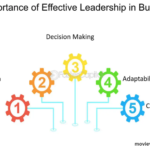In today’s competitive business world, effective leadership is essential for achieving excellence. The ultimate goal of business excellence is to streamline operations, enhance productivity, and achieve long-term success. Leadership plays a key role in setting the vision, motivating employees, and guiding the organization toward its objectives. In this guide, we will explore the key components of leading for business excellence, strategies for improving leadership, and practical steps for implementing these strategies in your business.
Key Points:
- Effective leadership fosters a positive work culture and motivates employees to perform at their best.
- Strong leadership enables organizations to navigate challenges and adapt to changing market demands.
- Leading with a focus on excellence ensures long-term business success and sustainability.
What Does Leading for Business Excellence Mean?
Leading for business excellence involves creating a culture of high performance, continuous improvement, and innovation within an organization. It’s about empowering employees to strive for their best, setting clear goals, and aligning everyone’s efforts toward achieving these objectives. Business leaders who embrace excellence make decisions based on long-term value rather than short-term gains. This holistic approach ensures the organization consistently delivers exceptional results.
A practical example of leading for business excellence can be seen in companies like Apple. Steve Jobs, the co-founder of Apple, set a high standard for innovation and design excellence. He pushed his teams to think differently, ensuring that every product reflected the company’s commitment to quality and innovation. Through his leadership, Apple became one of the most valuable and successful companies in the world.
How Can Leadership Influence Business Excellence?
Leadership has a profound impact on an organization’s pursuit of excellence. Leaders set the tone for the culture, provide direction, and make critical decisions that shape the organization’s future. Here’s how leadership influences business excellence:
- Vision and Strategy
A leader’s vision acts as a roadmap for the organization. They are responsible for setting a clear, compelling vision that inspires and aligns the entire team. This vision guides decision-making and ensures that everyone in the company understands the long-term goals. For example, Elon Musk’s vision for Tesla and SpaceX is centered around innovation and sustainability. This vision has helped him create a thriving business empire focused on excellence. - Effective Communication
Great leaders communicate effectively. They must be able to share the company’s vision, goals, and strategies with clarity. Open communication also promotes a culture of transparency, where employees feel informed and valued. When employees understand the “why” behind a decision, they are more likely to be motivated and contribute positively to the company’s success. - Leading by Example
Leaders must set the standard through their own actions. When they demonstrate a commitment to excellence in everything they do, their teams are more likely to follow suit. Whether it’s maintaining high standards, being consistent in decision-making, or taking responsibility for failures, leading by example is essential for cultivating business excellence. - Motivating and Inspiring Teams
Leadership is not just about giving orders; it’s about motivating and inspiring others. An inspiring leader helps employees see the value in their work, fostering a sense of purpose and pride. For example, Richard Branson of Virgin Group is known for empowering his teams and encouraging creativity. His leadership style has created a loyal and highly motivated workforce dedicated to business excellence.
What Are the Key Strategies for Leading for Business Excellence?
To lead for business excellence, leaders need to adopt certain strategies that focus on continuous improvement, employee development, and effective management. Here are some of the key strategies for achieving business excellence:
- Focus on Continuous Improvement
Business excellence requires a commitment to continuous improvement. Leaders must foster an environment where employees feel empowered to innovate, experiment, and refine their processes. A great example of this is Toyota’s implementation of the “Kaizen” approach, which focuses on small, continuous improvements that lead to big changes over time. By encouraging feedback and making incremental changes, leaders can drive sustainable business excellence. - Invest in Employee Development
Great leaders recognize the importance of developing their teams. Investing in training, mentorship, and personal development helps employees perform at their best. Companies that prioritize employee growth create a more skilled and loyal workforce. Google, for example, offers various training programs and encourages employees to pursue professional development opportunities. - Embrace Innovation
To stay ahead in the competitive landscape, leaders must embrace innovation. This means staying up-to-date with industry trends and adopting new technologies that can drive efficiency and improve products or services. Amazon’s founder, Jeff Bezos, revolutionized the retail industry by embracing e-commerce technology and continuously innovating its business model. - Customer-Centric Focus
Leaders must instill a customer-first mindset in their organizations. By focusing on the needs of the customer, businesses can ensure that they deliver products or services that add value. For example, Zappos has built a successful business model by prioritizing customer service, ensuring that every employee knows how to put the customer at the center of everything they do.
What Are the Benefits of Leading for Business Excellence?
Adopting a leadership style focused on business excellence offers several key benefits for both the company and its employees:
- Improved Operational Efficiency: Leadership focused on business excellence streamlines operations, removes inefficiencies, and drives cost savings. By encouraging process optimization and data-driven decision-making, leaders can achieve significant improvements in operational performance.
- Stronger Brand Reputation: A business that prioritizes excellence in every aspect builds a strong reputation among customers, employees, and investors. Consistently delivering high-quality products and services leads to trust and loyalty.
- Higher Employee Engagement: When leaders create an environment of growth and recognition, employees feel more engaged and motivated. This leads to higher productivity, lower turnover, and greater job satisfaction.
How Can Leaders Implement These Strategies in Their Organizations?
Implementing strategies for business excellence requires a combination of foresight, planning, and action. Here are some steps that leaders can take to ensure their strategies are effectively executed:
- Create a Clear Roadmap
Leaders should develop a roadmap outlining the steps required to achieve business excellence. This roadmap should be communicated to all employees so they understand their role in achieving the company’s goals. - Measure Progress and Outcomes
Tracking progress is crucial to ensuring that business excellence initiatives are on track. Leaders should use key performance indicators (KPIs) to measure success. This could include metrics such as customer satisfaction, operational efficiency, and employee retention rates. - Foster a Culture of Accountability
Accountability is key to driving business excellence. Leaders should set clear expectations and hold their teams accountable for meeting performance standards. Regular performance reviews and feedback sessions help employees stay focused on their goals. - Encourage Collaboration
Collaboration fosters innovation and problem-solving. Leaders should encourage cross-functional teams to work together on key projects, share ideas, and tackle challenges collectively.
Conclusion: The Power of Leading for Business Excellence
Leading for business excellence is a powerful approach that can transform an organization. It requires a commitment to vision, strategy, communication, and innovation. By adopting the strategies outlined in this guide, leaders can set their companies on a path to long-term success. Business excellence is not just about financial performance; it’s about creating an environment where employees thrive, customers are satisfied, and the company achieves its fullest potential.
FAQs
- What are the main principles of leading for business excellence? The main principles include continuous improvement, innovation, customer-centricity, and employee development.
- How can leadership drive innovation in an organization? By encouraging creative thinking, fostering an open environment for ideas, and embracing new technologies and processes.
- Why is employee development important for business excellence? Investing in employees helps build a skilled workforce, improving performance and increasing overall productivity.
- What role does customer satisfaction play in business excellence? A customer-first approach ensures that the business is consistently delivering value, which builds loyalty and strengthens the brand.
- How can I measure progress towards business excellence? Use KPIs, customer feedback, employee engagement metrics, and financial performance indicators to track progress.


